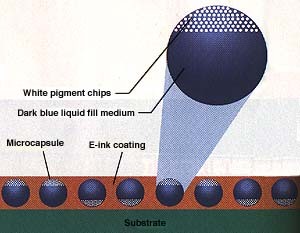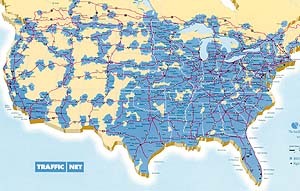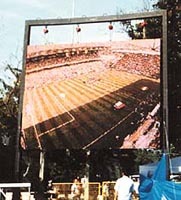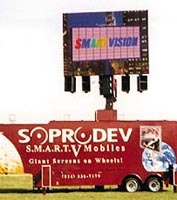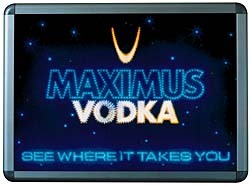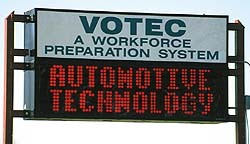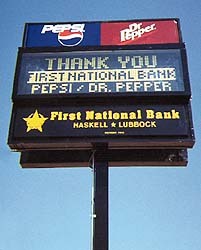"Good morning, Mr. Phelps. Your mission, should you decide to accept it, is to investigate and report on the rapidly changing world of electronic signage. In the event this mission fails, the editor will disavow any knowledge of your activities. You will be provided with a new identity, and a position will be created for you as a sign mechanic in Hoboken. This message will self-destruct in 10 seconds."
Disappearing ink, hide-away video screens and satellite-relay networks may sound like spy-movie props, but they also represent the cutting edge of today’s moving-message technology. Two principal characteristics distinguish technical developments in the world of electronic signs. The first is a marriage of simplicity and complexity. Although many electronic displays operate according to elementary principles, the hardware and software required to translate simple theory into an effective product can be mind-boggling. Second, an interdisciplinary approach freely borrows techniques and devices from other industries to constantly improve electronic signs and create new products.
Fortunately, the level of originality that prevails in the scientific world vastly exceeds the norms for Hollywood or Madison Avenue. That’s because scientists make truly groundbreaking discoveries, instead of merely repackaging and selling someone else’s idea. In this age of brokered nostalgia, you might be obliged to relive bad 1960s TV shows as feature-length films, or catch yourself humming along to "Suite: Judy Blue Eyes" on the supermarket intercom. Although it might be difficult to make the jump from Peter Graves and Martin Landau to Jon Voight and Tom Cruise, today’s world is clearly a place where technical wizard Barney Collier (Greg Morris) would feel comfortable.
Electronic ink
On your way to work, you pass by what appears to be an ordinary, painted sign that reads, "Have a great morning with Smith’s Coffee!" Passing by the same sign after work, you do a double-take when you notice that the message now reads, "Luxurious dining at Shaw’s Restaurant." Sitting on a park bench, you watch in amazement as a flat cardboard poster on the rear of a bus changes to a new message. In the era of E ink, these experiences will become commonplace.
Potentially the most revolutionary invention in the history of printing, electronic ink is the brainchild of Joe Jacobson, an assistant professor at the Massachusetts Institute of Technology’s (MIT) Media Lab. Developed by E Ink’s (Cambridge, MA) young scientists Barrett Comiskey and J.D. Albert, electronic ink comprises millions of tiny capsules suspended in liquid. Each capsule contains a mixture of dye and pigment chips that reacts to electric charges by changing between two contrasting colors.
Advertisement
The structure of each capsule resembles a clear beach ball filled with dark-blue-colored water and several dozen white ping-pong balls. When message data is sent to the display, the capsules change color to display text according to whether the white balls (pigment chips) are at the surfaces of the capsules or submerged beneath the dark, carrier liquid (Fig. 1). Although E-ink’s fundamental operating principle resembles the flash cards used by college football fans, the research and development behind E-ink displays is extremely complex.
Electronic ink may be applied to any surface — flat, curved or irregular — via ordinary printing or screen-printing equipment. The display’s background color can match the color of the surface on which the ink is applied. This will enable manufacturers to apply "pop-up" instructions and warning labels to a variety of consumer products. On ordinary documents, running E-ink-coated paper through a printer or fax machine will change the copy by tapping new charges onto the microcapsules. For larger-format E-ink displays, embedded pagers will permit instantaneous message updates of any number of displays from a single source.
At present, E ink can be produced in any two-color combination; but the capability to produce full-color displays is not far beyond the horizon. The company is presently tackling the difficult challenge of reducing the text size that can be produced. The ultimate goal is to create changeable, reusable newspapers, books and documents. Creator Jacobson calls this concept of a single, bound volume of electronic ink-coated pages "the last book." Newspaper subscribers in the future might receive a more-durable, E-ink version of their local newspaper that will last for several years and will be updated daily.
Coincidentally, the fact that this technology is currently limited to larger-size text applications dictates that the first commercial E-ink products will be signs. The company plans to roll out its first retail-store signs later this year. As a strong vote of confidence in the fledgling technology, some major corporations and venture capitalists have already invested $15.8 million in E Ink. At the end of October 1998, the Defense Advanced Research Projects Agency (DARPA) made an R&D grant of $373,000 to the company. This is clearly a major technological breakthrough that Signs of the Times will continue to monitor in "The Moving Message" column.
Orbital links
Wireless control of existing electronic-sign networks is already an option for advertisers and public-transportation departments. Cue Corp. (Irvine, CA) boasts the world’s largest network for transmitting radio data. The company provides nationwide and regional messaging throughout North America via the FM subcarrier facilities of more than 600 local radio stations (Fig. 2). This network reaches more than 95 percent of the North American population.
Advertisement
Using Cue’s data pager, the user can update electronic-sign messages as often as desired. The data is transmitted via satellite to individual radio stations or groups of stations, depending on the desired area of coverage. Special data receivers connected to the electronic signs pick up the message broadcasts.
This system provides users with a high degree of flexibility in delivering coordinated, time-sensitive messages across large geographical areas. It elevates electronic-sign marketing to a new level by allowing instantaneous message delivery according to regional demographics and local time differences. This represents a potent new tool for electronic-sign users.
Pop-up LEDs and P-O-Ps
If you think that the Irish are fanatical about soccer, you probably haven’t visited Brazil. When the 1998 World Cup took place in France, several million Brazilians had a keen interest in watching their national team defend its championship.
|2140| (Clearwater, FL) sold two full-color LED displays (Fig. 3) to Radio Imprenza (Rio de Janiero, S
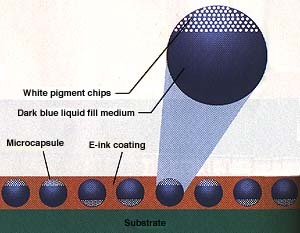

 Photo Gallery2 weeks ago
Photo Gallery2 weeks ago
 Paula Fargo2 weeks ago
Paula Fargo2 weeks ago
 Real Deal1 week ago
Real Deal1 week ago
 Photo Gallery2 weeks ago
Photo Gallery2 weeks ago
 Projects1 week ago
Projects1 week ago
 Women in Signs2 weeks ago
Women in Signs2 weeks ago
 Signs of the Times2 weeks ago
Signs of the Times2 weeks ago
 Business Management7 days ago
Business Management7 days ago
